

Compact Muon Solenoid
LHC, CERN
| CMS-SMP-14-017 ; CERN-PH-EP/2015-299 | ||
| Measurement of the inclusive jet cross section in pp collisions at $\sqrt{s} = $ 2.76 TeV | ||
| CMS Collaboration | ||
| 19 December 2015 | ||
| Eur. Phys. J. C 76 (2016) 265 | ||
| Abstract: The double-differential inclusive jet cross section is measured as a function of jet transverse momentum $p_{\mathrm{T}}$ and absolute rapidity $| y |$, using proton-proton collision data collected with the CMS experiment at the LHC, at a center-of-mass energy of $\sqrt{s} = $ 2.76 TeV and corresponding to an integrated luminosity of 5.43 pb$^{-1}$. Jets are reconstructed within the $p_{\mathrm{T}}$ range of 74 to 592 GeV and the rapidity range $| y |< $ 3.0 . The reconstructed jet spectrum is corrected for detector resolution. The measurements are compared to the theoretical prediction at next-to-leading-order QCD using different sets of parton distribution functions. This inclusive cross section measurement explores a new kinematic region and is consistent with QCD predictions. | ||
| Links: e-print arXiv:1512.06212 [hep-ex] (PDF) ; CDS record ; inSPIRE record ; HepData record ; CADI line (restricted) ; | ||
| Figures | |
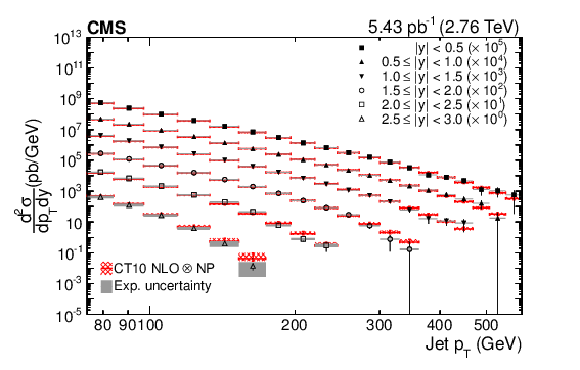
png pdf |
Figure 1:
The inclusive jet production cross section, measured at $\sqrt {s}= $ 2.76 TeV, shown as a function of jet ${p_{\mathrm {T}}}$ in six $ {| y | }$ bins, as indicated by different symbols. The statistical (systematic) experimental uncertainties are indicated by vertical error bars (filled bands). The measurements are compared to the NLO QCD prediction using CT10 PDF set. The theoretical uncertainties are represented by hatched bands. |
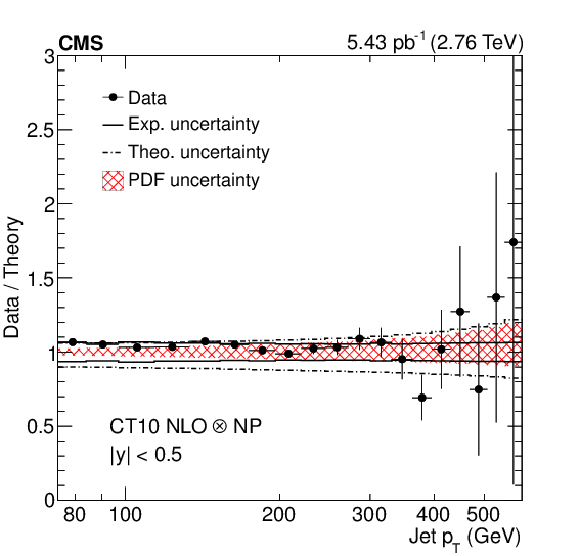
png pdf |
Figure 2-a:
The ratio of the measured inclusive jet production cross section (closed symbols) at $\sqrt {s}= $ 2.76 TeV to the theoretical prediction using the CT10 PDF set is shown as a function of jet ${p_{\mathrm {T}}}$ in each measured $ {| y | }$ range with the statistical (vertical error bars) and systematic (solid lines) experimental uncertainties. The total theoretical uncertainties are shown by the dash-dotted lines with the contribution from PDF uncertainties (hatched band). |

png pdf |
Figure 2-b:
The ratio of the measured inclusive jet production cross section (closed symbols) at $\sqrt {s}= $ 2.76 TeV to the theoretical prediction using the CT10 PDF set is shown as a function of jet ${p_{\mathrm {T}}}$ in each measured $ {| y | }$ range with the statistical (vertical error bars) and systematic (solid lines) experimental uncertainties. The total theoretical uncertainties are shown by the dash-dotted lines with the contribution from PDF uncertainties (hatched band). |
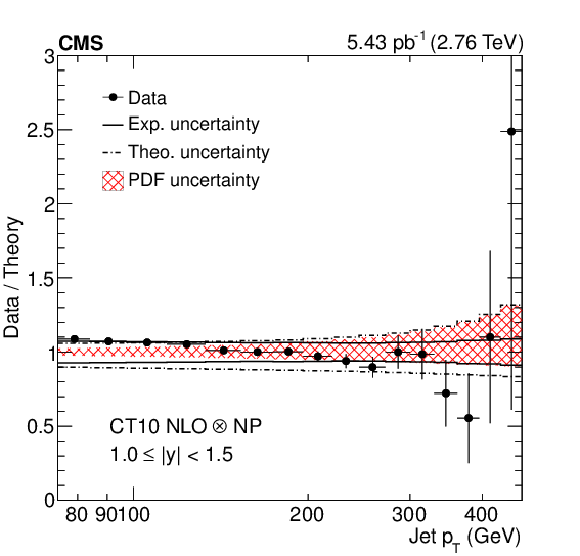
png pdf |
Figure 2-c:
The ratio of the measured inclusive jet production cross section (closed symbols) at $\sqrt {s}= $ 2.76 TeV to the theoretical prediction using the CT10 PDF set is shown as a function of jet ${p_{\mathrm {T}}}$ in each measured $ {| y | }$ range with the statistical (vertical error bars) and systematic (solid lines) experimental uncertainties. The total theoretical uncertainties are shown by the dash-dotted lines with the contribution from PDF uncertainties (hatched band). |
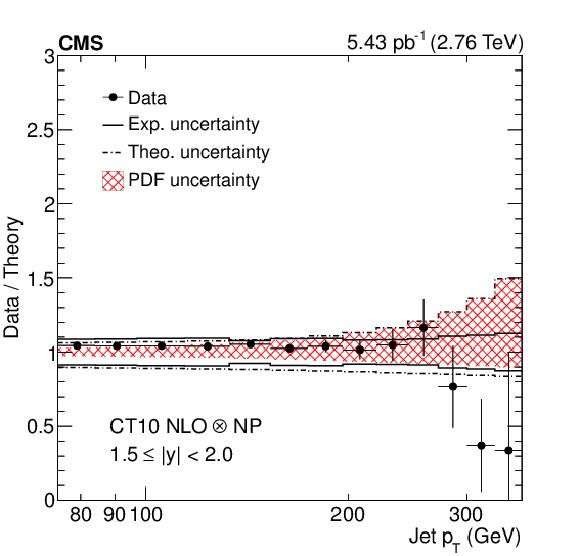
png pdf |
Figure 2-d:
The ratio of the measured inclusive jet production cross section (closed symbols) at $\sqrt {s}= $ 2.76 TeV to the theoretical prediction using the CT10 PDF set is shown as a function of jet ${p_{\mathrm {T}}}$ in each measured $ {| y | }$ range with the statistical (vertical error bars) and systematic (solid lines) experimental uncertainties. The total theoretical uncertainties are shown by the dash-dotted lines with the contribution from PDF uncertainties (hatched band). |

png pdf |
Figure 2-e:
The ratio of the measured inclusive jet production cross section (closed symbols) at $\sqrt {s}= $ 2.76 TeV to the theoretical prediction using the CT10 PDF set is shown as a function of jet ${p_{\mathrm {T}}}$ in each measured $ {| y | }$ range with the statistical (vertical error bars) and systematic (solid lines) experimental uncertainties. The total theoretical uncertainties are shown by the dash-dotted lines with the contribution from PDF uncertainties (hatched band). |

png pdf |
Figure 2-f:
The ratio of the measured inclusive jet production cross section (closed symbols) at $\sqrt {s}= $ 2.76 TeV to the theoretical prediction using the CT10 PDF set is shown as a function of jet ${p_{\mathrm {T}}}$ in each measured $ {| y | }$ range with the statistical (vertical error bars) and systematic (solid lines) experimental uncertainties. The total theoretical uncertainties are shown by the dash-dotted lines with the contribution from PDF uncertainties (hatched band). |

png pdf |
Figure 3-a:
The same data shown in Fig. 2 are presented showing comparisons to the NLO QCD predictions using a variety of PDFs, which are denoted by different line styles. The uncertainties corresponding to the QCD predictions are not shown. For simplicity, the NP corrections needed for the various QCD predictions have been applied to the data in this figure. |
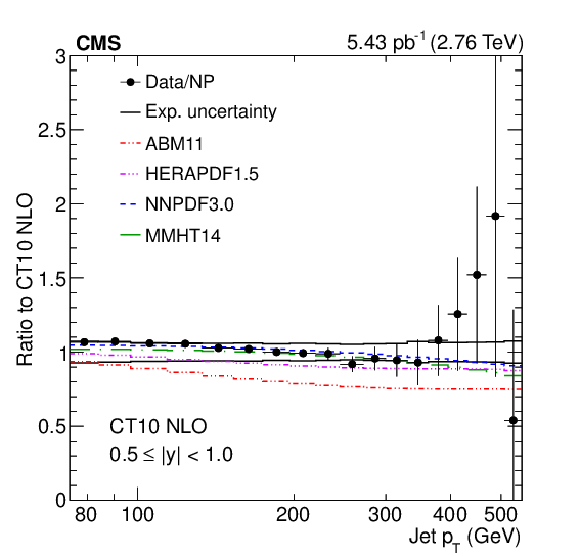
png pdf |
Figure 3-b:
The same data shown in Fig. 2 are presented showing comparisons to the NLO QCD predictions using a variety of PDFs, which are denoted by different line styles. The uncertainties corresponding to the QCD predictions are not shown. For simplicity, the NP corrections needed for the various QCD predictions have been applied to the data in this figure. |

png pdf |
Figure 3-c:
The same data shown in Fig. 2 are presented showing comparisons to the NLO QCD predictions using a variety of PDFs, which are denoted by different line styles. The uncertainties corresponding to the QCD predictions are not shown. For simplicity, the NP corrections needed for the various QCD predictions have been applied to the data in this figure. |

png pdf |
Figure 3-d:
The same data shown in Fig. 2 are presented showing comparisons to the NLO QCD predictions using a variety of PDFs, which are denoted by different line styles. The uncertainties corresponding to the QCD predictions are not shown. For simplicity, the NP corrections needed for the various QCD predictions have been applied to the data in this figure. |

png pdf |
Figure 3-e:
The same data shown in Fig. 2 are presented showing comparisons to the NLO QCD predictions using a variety of PDFs, which are denoted by different line styles. The uncertainties corresponding to the QCD predictions are not shown. For simplicity, the NP corrections needed for the various QCD predictions have been applied to the data in this figure. |
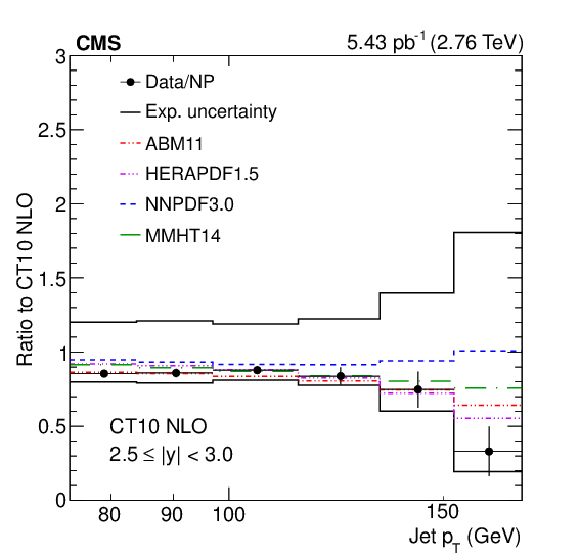
png pdf |
Figure 3-f:
The same data shown in Fig. 2 are presented showing comparisons to the NLO QCD predictions using a variety of PDFs, which are denoted by different line styles. The uncertainties corresponding to the QCD predictions are not shown. For simplicity, the NP corrections needed for the various QCD predictions have been applied to the data in this figure. |
| Tables | |

png pdf |
Table 1:
Effective integrated luminosities and jet ${p_{\mathrm {T}}}$ ranges for triggers used in this study. |
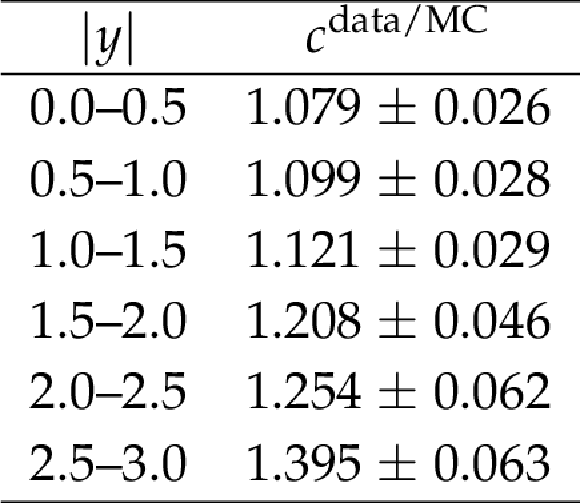
png pdf |
Table 2:
The factors used to scale jet resolution determined in simulations to match the resolution observed in data. |

png pdf |
Table 3:
The PDF sets used for deriving cross section predictions are given with the number of active flavors ($N_\mathrm {f}$), the values and ranges of ${\alpha _\mathrm {S}(M_{\mathrm{ Z } })}$ used for the fits, and corresponding references. |
| Summary |
|
A measurement of the double-differential inclusive jet cross section was presented. The data were collected by the CMS detector in pp collisions at $\sqrt{s} = $ 2.76 TeV, with an integrated luminosity of 5.43 pb$^{-1}$. The measurement covers the jet kinematic ranges of 74 $ \leq p_{\mathrm{T}} < $ 592 GeV and $ | y |< $ 3.0 . A detailed study of the experimental and theoretical uncertainties has been performed. Contributions to the experimental systematic uncertainty were evaluated from the jet energy corrections, jet energy resolution, and integrated luminosity. Jet energy corrections dominate the experimental uncertainty, followed by smaller contributions from jet energy resolution and luminosity. The theoretical uncertainty is dominated by the missing higher-order corrections that were estimated by varying the renormalization and factorization scales, and the PDF uncertainty; the contribution of nonperturbative correction uncertainty is small. The data are corrected for detector resolution and efficiencies. The measured cross sections are compared to NLO QCD predictions obtained using different PDF sets. These cross section measurements test and confirm the predictions of QCD at $\sqrt{s}= $ 2.76 TeV and extend the kinematic range compared to previous studies. |
| References | ||||
| 1 | G. Altarelli and G. Parisi | Asymptotic freedom in parton language | Nucl. Phys. B 126 (1977) 298 | |
| 2 | V. Gribov and L. Lipatov | Deep inelastic ep scattering in perturbation theory | Sov. J. Nucl. Phys. 15 (1972) 438 | |
| 3 | Y. L. Dokshitzer | Calculation of the Structure Functions for Deep Inelastic Scattering and e$ ^+ $e$ ^- $ Annihilation by Perturbation Theory in Quantum Chromodynamics | Sov. Phys. JETP 46 (1977) 641 | |
| 4 | CMS Collaboration | Constraints on parton distribution functions and extraction of the strong coupling constant from the inclusive jet cross section in pp collisions at $ \sqrt{s} = 7 $$ TeV $ | EPJC 75 (2015) 288 | |
| 5 | CMS Collaboration | Measurements of differential jet cross sections in proton-proton collisions at $ \sqrt{s} = $ 7 TeV with the CMS detector | PRD 87 (2013) 112002 | |
| 6 | ATLAS Collaboration | Measurement of inclusive jet and dijet production in pp collisions at $ \sqrt{s}=7 $ TeV using the ATLAS detector | PRD 86 (2012) 014022 | 1112.6297 |
| 7 | ATLAS Collaboration | Measurement of the inclusive jet cross section in pp collisions at $ \sqrt{s}=2.76 $ TeV and comparison to the inclusive jet cross section at $ \sqrt{s}=7 $ TeV using the ATLAS detector | EPJC 73 (2013) 2509 | 1304.4739 |
| 8 | ALICE Collaboration | Measurement of the inclusive differential jet cross section in pp collisions at $ \sqrt{s}~=~ $2.76 TeV | PLB 722 (2013) 262 | 1301.3475 |
| 9 | UA1 Collaboration | Hadronic jet production at the CERN proton-antiproton collider | Phy. Lett. B 132 (1983) 214 | |
| 10 | UA1 Collaboration | Measurement of the inclusive jet cross-section at the CERN p$ \bar{\mathrm{p}} $ collider | PLB 172 (1986) 461 | |
| 11 | UA2 Collaboration | Observation of very large transverse momentum jets at the CERN p$ \bar{\mathrm{p}} $ collider | PLB 118 (1982) 203 | |
| 12 | UA2 Collaboration | Measurement of the $ \sqrt{s} $~dependence of jet production at the CERN $ \bar{\mathrm{p}} $p collider | PLB 160 (1985) 349 | |
| 13 | CDF Collaboration | Measurement of the inclusive jet cross section using the k$ _\mathrm{t} $ algorithm in $ p\bar{p} $ collisions at $ \sqrt{s} = 1.96 $ TeV with the CDF II detector | PRD 75 (2007) 092006, , [Erratum: \DOI10.1103/PhysRevD.75.119901] | hep-ex/0701051 |
| 14 | CDF Collaboration | Comparison of jet production in $ p\bar{p} $ collisions at $ \sqrt{s} = 546 $ GeV and 1800 GeV | PRL 70 (1993) 1376 | |
| 15 | D0 Collaboration | Measurement of the inclusive jet cross section in $ p\bar{p} $ collisions at $ \sqrt{s}=1.96 $ TeV | PRD 85 (2012) 052006 | 1110.3771 |
| 16 | D0 Collaboration | High-$ p_T $ jets in $ p\bar{p} $ collisions at $ \sqrt{s} = 630 $ GeV and 1800 GeV | PRD 64 (2001) 032003 | hep-ex/0012046 |
| 17 | Z. Nagy | Three-jet cross sections in hadron-hadron collisions at next-to-leading order | PRL 88 (2002) 122003 | hep-ph/0110315 |
| 18 | Z. Nagy | Next-to-leading order calculation of three-jet observables in hadron-hadron collisions | PRD 68 (2003) 094002 | hep-ph/0307268 |
| 19 | D. Britzger, K. Rabbertz, F. Stober, and M. Wobisch | New features in version 2 of the fastNLO project | in XX Int'l Workshop on Deep-Inelastic Scattering and Related Subjects, p. 217 2012 | 1208.3641 |
| 20 | S. Dittmaier, A. Huss, and C. Speckner | Weak radiative corrections to dijet production at hadron colliders | JHEP 11 (2012) 095 | 1210.0438 |
| 21 | CMS Collaboration | The CMS experiment at the CERN LHC | JINST 3 (2008) S08004 | CMS-00-001 |
| 22 | CMS Collaboration | Particle--Flow Event Reconstruction in CMS and Performance for Jets, Taus, and $ E_{\mathrm{T}}^{\text{miss}} $ | CDS | |
| 23 | CMS Collaboration | Commissioning of the Particle-flow Event Reconstruction with the first LHC collisions recorded in the CMS detector | CDS | |
| 24 | C. Matteo, S. Gavin, and G. Soyez | The anti-$ k_t $ jet clustering algorithm | JHEP 04 (2008) 063 | 0802.1189 |
| 25 | M. Cacciari, G. Salam, and G. Soyez | FastJet user manual | EPJC 72 (2012) 1896 | 1111.6097 |
| 26 | CMS Collaboration | Determination of jet energy calibration and transverse momentum resolution in CMS | JINST 6 (2011) P11002 | |
| 27 | T. Sj\"ostrand, S. Mrenna, and P. Skands | PYTHIA 6.4 physics and manual | JHEP 05 (2006) 26 | hep-ph/0603175 |
| 28 | GEANT4 Collaboration | GEANT4---a simulation toolkit | NIMA 506 (2003) 250 | |
| 29 | R. Field | Early LHC Underlying Event Data - Findings and Surprises | 1010.3558 | |
| 30 | J. Pumplin et al. | New generation of parton distributions with uncertainties from global QCD analysis | JHEP 07 (2002) 012 | hep-ph/0201195 |
| 31 | R. Field | Min-Bias and the Underlying Event at the LHC | 1110.5530 | |
| 32 | H. Lai et al. | New parton distributions for collider physics | PRD 82 (2010) 074024 | 1007.2241 |
| 33 | H. Akima | A New Method of Interpolation and Smooth Curve Fitting Based on Local Procedures | J. ACM 17 (1970) 589 | |
| 34 | G. D'Agostini | A multidimensional unfolding method based on Bayes' theorem | NIMA 362 (1995) 487 | |
| 35 | T. Adye | Unfolding algorithms and tests using RooUnfold | 1105.1160 | |
| 36 | L. A. Harland-Lang, A. D. Martin, P. Motylinski, and R. S. Thorne | Parton distributions in the LHC era: MMHT 2014 PDFs | EPJC 75 (2015) 204 | 1412.3989 |
| 37 | R. D. Ball et al. | Parton distributions for the LHC run II | JHEP 04 (2015) 40 | 1410.8849 |
| 38 | H1 and ZEUS Collaborations | Combined Measurement and QCD Analysis of the Inclusive e$ ^{\pm} $p Scattering Cross Sections at HERA | JHEP 01 (2010) 109 | 0911.0884 |
| 39 | S. Alekhin, J. Bl\"umlein, and S. Moch | Parton distribution functions and benchmark cross sections at next-to-next-to-leading order | PRD 86 (2012) 054009 | 1202.2281 |
| 40 | M. B\"ahr et al. | Herwig++ physics and manual | EPJC 58 (2008) 639 | 0803.0883 |
| 41 | S. Gieseke, C. R\"ohr, and A. Si\'odmok | Colour reconnections in Herwig++ | EPJC 72 (2012) 2225 | 1206.0041 |
| 42 | B. Andersson | The Lund model | Nucl. Phys. A 461 (1987) 513 | |
| 43 | B. R. Webber | A QCD model for jet fragmentation including soft gluon interference | Nucl. Phys. B 238 (1984) 492 | |
| 44 | CMS Collaboration | Luminosity Calibration for the 2013 Proton-Lead and Proton-Proton Data Taking | CMS-PAS-LUM-13-002 | CMS-PAS-LUM-13-002 |

|
Compact Muon Solenoid LHC, CERN |

|

|

|

|

|

|